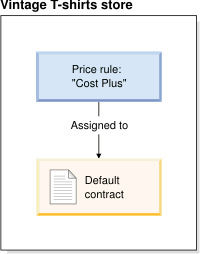
Scenario 1: B2C store using a simple price rule
The following scenario shows how a pricing manager for a B2C store might use a simple price rule to manage pricing. This scenario highlights the following price rule concepts: simple equations in price rules and rounding prices.
Site description
A retail vintage t-shirt business with a single store.What the pricing manager wants to do
The pricing manager currently uses an Offer Price list to display t-shirt prices to customers on the storefront. Instead, he wants to base pricing on his cost to make each t-shirt. For this purpose, he has created a T-Shirt Cost price list. For now, he wants to mark up his cost by 15%. Over time, he wants the ability to change the markup percentage quickly and easily to suit the current t-shirt market.How the pricing manager uses price rules
To achieve his pricing goals, the pricing manager creates a price rule called Cost Plus and assigns it to the default contract for his store, as shown in the following diagram:
When customers view t-shirts on the storefront, the prices they see are calculated using this price rule.
The Cost Plus price rule looks like this:

The actions used in this price rule work like this:
| Get Price from Price List | Looks up the price of the t-shirt the customer is viewing in the T-Shirt Cost price list. This price is used as input to the next action in the price rule. |
| Calculate Price | Marks up the cost from the T-Shirt Cost price list by 15%. |
| Apply Rounding | Rounds up the calculated price so that the price ends with either ".49" or ".99" |
Highlights of this scenario
- With price rules, you can use the Offer Price list, or any other price list, to mark up or mark down prices for products on your storefront.
- By including a simple equation in a price rule, you can dynamically adjust prices in a price list by changing the equation, rather than changing each price in the price list. For example, if the pricing manager wants to mark up his costs by 20% instead of 15%, he can change the percentage in the Calculate Price action. As a result, the storefront uses the revised price rule to calculate prices.
- When you use price rules to perform a calculation and output a new price, you can make the prices look more attractive to customers using the Apply Rounding action.